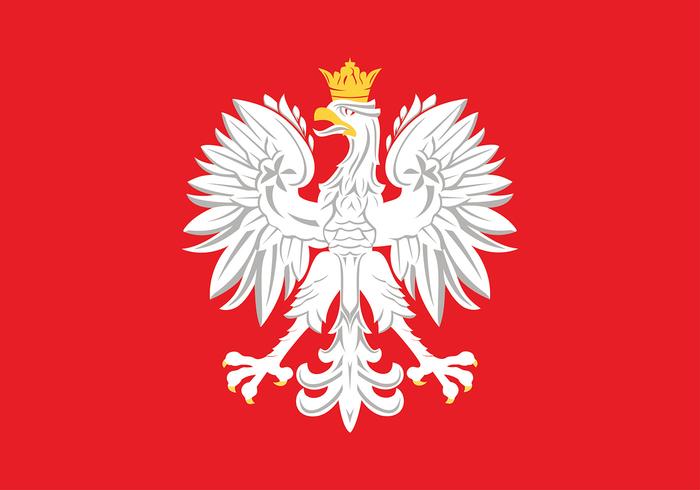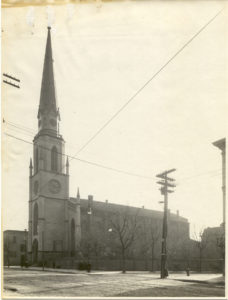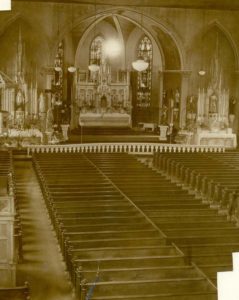St. Mary Church
Toledo Polish Churches > St. Mary Church
St. Mary (of the Assumption) Parish: the First German Catholic Church in Toledo, Ohio
The first pastor of the first parish in Toledo was Father Amadeus Rappe, in September 1841. The first church was dedicated to St. Francis de Sales; services were held in an old Presbyterian meeting house on Superior Street since November 1842. The church was enlarged to accommodate German Catholics in 1849. The existing St. Francis de Sales church was built between 1852 and 1870. Separate services were conducted for the Germans until St. Mary’s church was finished in 1856. Most parishioners of St. Francis in the mid to late 1800s were Irish. There are no records of Poles attending the sacraments in St. Francis records.
In November 1853, about 200 German parishioners of St. Francis de Sales petitioned the Right Reverend Amadeus Rappe (the same priest as above), by that time the first bishop of the Cleveland diocese, for permission to build a church for themselves, and a pastor who spoke German. Permission was granted in January 1854, and Father Charles Evrard was appointed pastor of the German Catholics in Toledo and its vicinity. Two lots with a frontage of 150 feet on Cherry Street and 200 feet on Michigan Street were purchased for $ 5,100. This property was located on the southwestern corner of the intersection, and just three blocks north of St. Francis de Sales church. The cost of the building was $ 12,000, and the the total debt of $ 17,100 was cancelled in 1862.
This location was just south of the Wabash and Erie Canal bed (completed in 1843), also known as “the Big Ditch.” A wooden bridge ran over the big ditch where it intersected with Cherry Street. Remnants of the big ditch could be seen east of Cherry Street until this last segment of the canal bed was filled in just a few years ago. The Diocese of Toledo offices building is just to the north of this site.
On Rosary Sunday 1856, Bishop Rappe sang the first High Mass in the new St. Mary’s church. Dedication was held on March 25, 1857 by the well-known Jesuit Father F. X. Wenninger, a popular missionary, placing the church under the patronage of the Blessed Virgin Mary of the Assumption. Naming German Catholic churches “St. Mary (of the Assumption)” was common during this time.
The spire was built in 1865, and many improvements were made between July 1864 and 1867, amounting to $ 45,000, 2/3 of which was paid during that time. A large basement was under the church, the front of which served as a parish school, and the rear as a pastoral residence. The school was placed in charge of the Ursuline Sisters in 1867.
Both St. Francis and St. Mary’s had parish cemeteries, side by side, at the northwestern corner of Lagrange Street and Manhattan Boulevard, outside the city limits at mid-nineteenth century. The cemetery was in use by 1843. The cemetery was expanded and is now called Mount Carmel Cemetery. Several of the Jesuit pastors of St. Mary’s are buried in the Jesuit priest area in St. Mary’s cemetery. For more information about these cemeteries, and their records, see the separate entry for cemeteries.
In August 1869, Bishop Rappe called on the Jesuits of the former Buffalo mission of the German province of the Society of Jesus to minister to the parishioners of St. Mary’s, until 1995. Father Peter Spicher was the first Jesuit pastor. Father Nicholas Griesch erected the three-story school building behind the church, fronting on Orange Street. School was held the first time in the new building in September 1874. The Ursuline Sisters staffed the school until 1877, when Pastor Wilhelm Kockerols chose the Sisters of Notre Dame.
It was here at St. Mary’s church that the first Poles chose to attend services and sacraments in the 1860s and 1870s, before the opening of St. Hedwig church in 1875. Very few Polish records can be found at St. Mary’s after 1875, though the Polish people used St. Mary’s Cemetery until the opening of Calvary Cemetery in 1887.
In 1866, a new parish, Saints Peter and Paul, was opened in the expanding German area of Toledo called Lenks Hill. Poles who settled in the Kuhschwanz area attended services at this church until the founding of St. Anthony’s.
The church was lengthened allowing for the expansion of the sanctuary in 1880. Father Clement Alten built a new school building on Page Street, opening in January 1904. The lots, building and interior cost about $ 126,000. A new church and auditorium were also built at this location, and completed in 1904. The new St. Mary’s sat on two acres of land on the north side of Page Street, between Cherry and Vermont Avenue, beside St. Vincent Hospital on Cherry Street. Masses were said at both locations until 1932, and the old church at Cherry and Michigan was razed in 1934.
Membership began to decline. In 1941, there were 2,000 members, but by 1980, there were only 700. The parish was closed on June 30, 2005. Sacramental records are located at the Diocesan Archives, and can also be found in the LDS microfilm collection and its online website.
| St. Mary (German) old building at Cherry & Michigan
The old St. Mary church building was built in 1854 at the southwest corner of Cherry Street at Michigan, just yards away from the old Wabash & Erie Canal bed. Later, the parish was moved further north to Page Street near Cherry. |
| St. Mary (German) church interior, old building on Cherry and Michigan
This is the interior view of the old St. Mary Parish church once located at Cherry Street and Michigan, in downtown Toledo. |
| Old St. Mary
This is a view from before 1933. It is reported to have been the tallest church in the city of Toledo, at 257 feet and had a slate roof.
|
Pastors of St. Mary Parish:
Reverend Charles Evrard (1854-1867)
Reverend Christian Viere (1867-1869)
Reverend Peter Spicher (1869-1870) (First of the Jesuit pastors)
Reverend John B. Kanzleiter (1870-1872)
Reverend Nicholas Greisch (1872-1875)
Reverend William Kockerols (1875-1886)
Reverend Aloysius Sigg (1886-1890)
Reverend Michael Zoeller (1890-1893)
Reverend Peter Schnitzler (1893-1900)
Reverend Clement Alten (1900-1905)
Reverend August M. Hackert (1905-1910)
Reverend Stephen Hoehn (1910-1918)
Reverend Charles Jansen (1918-1921)
Reverend Herman Elskamp (1921-1923)
Reverend Francis Heierman (1923-1925)
Reverend Vincent Siefke (1925-1930)
Reverend William Schierman (1930-1932)
Reverend Charles Jansen (1932-1933)
Reverend William H. Wortkoetter (1933-1939)
Reverend Bernard A. Horn (1939-1941)
Reverend Hartford F. Brucke (1941-1969)
Reverend Charles E. Sullivan (1969-1977)
Reverend Robert A. Pollauf (1977-1982)
Reverend Patrick F. McManamon (1982-1984)
Reverend James Nusbaum (1984-1990)
Sister Virginia Welsh OSF, pastoral leader (1990-1998)
Reverend James O’Reilly, sacramental minister (1990-1995) (Last of the Jesuit priests)
Reverend Robert Wilhelm, canonical pastor (1990-1995)
Reverend Theodore Miller, chaplain (1995-1998)
Deacon Stanley Gogol, parish leader (1998)
Sister Phyllis Schenk OP, pastoral leader (1998-2005)
Reverend Ronald Warnimont, canonical pastor (1998-2005)
Patron Saint:
The Assumption of Mary, feast day August 15
After Mary’s death, her body and soul was assumed into heaven, and this was celebrated by Christians since at least the fifth century. It is a holy day of obligation. In 1950, Pope Pius XII defined the Assumption of Mary as a dogma of faith, although it was already a common belief in the Catholic Church.
Prayer:
Magnificat (see Luke 1:46-55)
Addresses:
First church: Cherry Street at Michigan Street
Second church: 219 Page Street, Toledo, Ohio 43620
Bilbiography:
Historic Ohio: Souvenir Volume of American Federation of Catholic Societies (published for the National Convention held in Toledo, Ohio, August 15 to 18, 1915), Toledo, Ohio, 1915
Clerus Toletanus: A Directory of Clergy, Religious Communities and Parishes of the Diocese of Toledo in America, 1910 to 2011, vol. 1 no. 1



